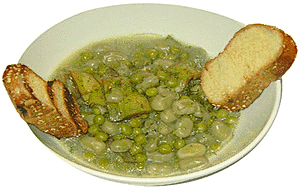
The change of season is always something seasonal cooks look forward to. At Bellavitae, we would welcome spring with fresh asparagus, peas, fava beans, artichokes, and morels.
In springtime, we should celebrate freshness, whether fruits and vegetables and served cooked or raw. A perfect illustration of this is the classic Sicilian dish fretedda (also called fritella – in Greece it’s koukia me anginares, in Rome it’s la vignarola and fresh peas are added). It’s a much-loved Mediterranean stew that is made at the end of the artichoke season and beginning of the fava bean season.
Best of Sicily magazine writer Roberta Gangi provides her recipe here. Clifford A. Wright offers his here. Nancy Harmon Jenkins’ Greek version is here. Note that while these recipes differ significantly, I would label them each authentic (my views on authenticity of classic recipes will be saved for another post when I have time for such a rant).
Reader Gida Ingrassia recently commented on my May 2010 post In Season: Asparagus and Fava Beans:
“I am looking for a recipe to make Sicilian “fritedda” with fava beans, asparagus, onions, peas and artichokes. Do you use regular artichokes and pare them down or are artichoke hearts necessary? Please advise.”
Well, I suppose I have already answered the question in the introduction! To understand this dish you need to understand its purpose: It is served in the Mediterranean when the artichoke and fava bean seasons cross. It celebrates spring freshness. So use fresh!
Gangi, Wright, and Jenkins give you specific instructions on how to cook the artichokes. Buy the youngest available, boil the hearts and tender leaves until partially forgiving but not yet quite soft enough to eat. Then add the other ingredients for further cooking.

Here are some tips for success:
- Make this dish as soon as fava beans come into season. Nancy Harmon Jenkins wrote recently in The Wall Street Journal: “It’s true that favas left to mature on their stalks too long will have a leathery skin that must be removed. Like peas, favas should be harvested and consumed when they are young.”
- Don’t listen to the food snobs who insist you peel the beans after they’ve been shucked. Again from Jenkins: “How tiresome—and unnecessary. That’s not how it’s done in Italy. Or in Greece, Spain, Lebanon, Great Britain or anywhere else the beans are a spring staple. Only in France do they call for peeling the beans. Go figure.”
- Use only the freshest ingredients. Avoid dried favas, bottled artichoke hearts, or canned peas (in a pinch, I may use frozen peas).
- Use Sicilian olive oil! This tip will transform the dish from very good to phenomenal! My favorite Sicilian olive oil is Pianogrillo Farm Extra Virgin Olive Oil available from Gustiamo or Amazon.
Thanks for the question, Gida. Let us know how it turns out.
Related:
Further Reading:
- Best of Sicily magazine: Fritedda (Fritella)
- CliffordAWright.com: Fritedda
- The Wall Street Journal: Stop Peeling Those Fava Beans